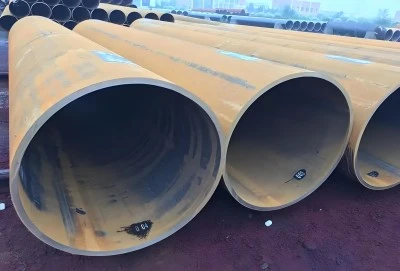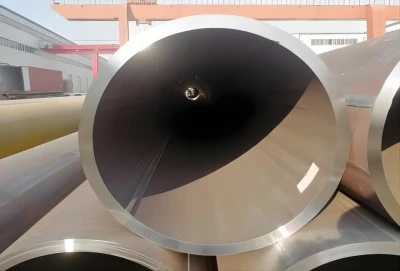When it comes to industrial piping systems, understanding the minimum wall thickness requirements for ASTM A672 pipe is crucial for ensuring safety, reliability, and compliance with industry standards. This comprehensive guide explores the key aspects of wall thickness determination, factors affecting selection, and specific requirements for different grades of A672 pipe.
|
|
|
How is the minimum wall thickness for ASTM A672 pipe determined?
The determination of minimum wall thickness for ASTM A672 pipe involves a comprehensive engineering analysis that considers multiple critical factors and follows established industry standards. The process begins with the calculation of pressure design thickness using applicable design codes such as ASME B31.3 or B31.8, which provide fundamental equations incorporating internal pressure, pipe diameter, and allowable stress values specific to the material grade selected.
The preliminary thickness calculation uses the basic Barlow's formula as a starting point, but this represents only the theoretical minimum needed to contain internal pressure. In practice, engineers must add several essential allowances to ensure long-term integrity and safe operation. A corrosion allowance is incorporated based on the expected corrosion rate in the service environment multiplied by the designed service life. This addition is crucial for maintaining structural integrity throughout the pipe's operational lifespan.
Manufacturing tolerances play a significant role in the final thickness specification. Since ASTM A672 allows for a negative tolerance of 12.5% on the nominal wall thickness, engineers must increase the specified thickness to ensure that even at the minimum allowable manufactured thickness, the pipe meets all design requirements. This consideration often leads to specifying a nominal thickness that is notably higher than the calculated minimum.
Temperature effects must be carefully evaluated, particularly given that A672 pipe is frequently used in low-temperature applications. The material's allowable stress values vary with temperature, and additional thickness may be required to account for thermal stresses, especially in cryogenic services. Furthermore, if the pipeline will be buried, the external loads from soil pressure, surface traffic, and other environmental forces must be factored into the thickness calculations.
The final minimum wall thickness specification must also account for mechanical allowances such as threading or grooving if required by the application, plus any future maintenance considerations like potential wall loss during surface preparation for recoating. All these factors are combined using established engineering practices to determine a final minimum wall thickness that ensures safe, reliable operation throughout the intended service life while complying with all applicable codes and standards.
What factors contribute to the wall thickness selection in ASTM A672 pipe?
1. Operating Pressure: Higher operating pressures require greater wall thickness to contain the internal pressure safely. The design pressure must include considerations for pressure surges and maximum operating conditions. Engineers must calculate the minimum wall thickness using applicable design codes (such as ASME B31.3 for process piping) and incorporate appropriate safety factors. Cyclic pressure loading should also be evaluated for fatigue considerations.
2. Temperature Conditions: Service temperature affects material strength properties and can require increased wall thickness. ASTM A672 pipe is commonly used in low-temperature services, and the temperature range must be carefully considered in thickness calculations. The material's allowable stress values vary with temperature, typically decreasing as temperature increases. For cryogenic applications, additional thickness may be required to maintain structural integrity under thermal stresses.
3. External Loads: Buried pipelines must withstand soil loads, traffic loads, and other external forces. These loads can necessitate increased wall thickness beyond what internal pressure alone would require. Factors such as soil type, burial depth, surface loading conditions, and potential ground movement must be analyzed. Support spacing and configuration for above-ground installations also influence thickness requirements.
4. Corrosion and Erosion: The expected corrosion rate in the service environment determines the corrosion allowance that must be added to the minimum required thickness. This ensures the pipe maintains its integrity throughout its designed service life. Factors affecting corrosion include:
- Media composition and chemistry
- Flow velocity and turbulence
- Temperature effects on corrosion rates
- Presence of inhibitors or protective coatings
- Environmental conditions for external corrosion
5. Manufacturing Tolerances: Wall thickness must account for the negative tolerance allowed in manufacturing. ASTM A672 specifications typically permit a negative tolerance of 12.5% on the nominal wall thickness. This means:
- The specified nominal thickness must be sufficient so that the minimum thickness after tolerance remains above the required minimum
- Quality control measures must verify thickness compliance
- Additional thickness may be specified to accommodate future machining or surface finishing
6. Code Requirements: Various industry codes and standards may impose additional thickness requirements based on:
- Safety class of the pipeline
- Location and accessibility for inspection
- Consequences of failure
- Required design life
- Local regulations and specifications
Are there any minimum wall thickness requirements for various grades of ASTM A672 pipe?
ASTM A672 pipe comes in different grades (B60, B70, C60, C70, etc.), each with specific strength properties and applications. While the standard itself doesn't specify absolute minimum wall thicknesses, the requirements vary based on the grade and class of pipe:
Grade B60/B70:
- Minimum tensile strength: 60,000/70,000 psi
- Typical applications: Moderate pressure services
- Wall thickness range: Usually starts from Schedule 20 upward
Grade C60/C70:
- Minimum tensile strength: 60,000/70,000 psi
- Heat-treated condition
- Common in low-temperature applications
- Wall thickness range: Often Schedule 40 and heavier
The actual minimum wall thickness must be calculated based on service conditions and applicable codes, such as ASME B31.3 or B31.8, depending on the application. These calculations must consider the specific material properties of each grade.
Trust Longma - Your Premier Source for ASTM A672 Pipes
For over 20 years, Longma has been a leading manufacturer and supplier of ASTM A672 pipes, delivering excellence in every inch of steel. Our certified pipes meet the most stringent international standards for high-pressure applications. Whether you need Grade C60, C65, or C70 pipes, our extensive inventory and professional team ensure prompt delivery and competitive pricing.
Don't let pipe procurement slow down your project. Contact Longma today:
- Email: [info@longma-group.com]
- Phone: [+8617697154766]














